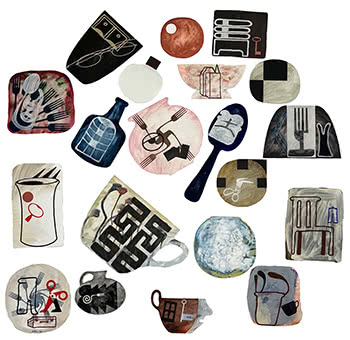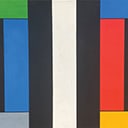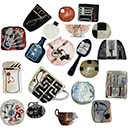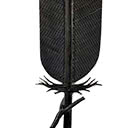Sill Life with James Joyce
162 x 190 cm
est. $30,000 - 40,000
 Relative size
Relative size
Following an early period as a realist painter in the 1960s, and a brief flirtation with camouflage patterns in the early 1970s, by 1974 Richard Killeen's interest in patterns led him to become a grid painter. Beetles and butterflies began to infiltrate his work in the later 1970s, and by 1978 he had made his first cut-out painting, Across the Pacific, using cardboard stencils to cut out 15 aluminium shapes which were then coated in black acrylic lacquer.
One of several works titled Still Life with James Joyce (another 79 piece iteration made in 1994 interrupted a line of Measuring Tools works and in 1995, Killeen made a 29 piece version), like the others, this one includes computer-generated images from Killeen's codex. Each features conventional still-life objects rendered as patterns: fork designs, spiralling, or spreading like a fan, as well as teacups, bottles, spoons and distorted scissors and spoons. Joyce's iconic wire-framed spectacles, evidence of his eyesight problems, which defined his image in photographs and caricatures, are reproduced prominently here, with arms folded across the lenses, silhouetted against a black cup background.
A portrait can be a still life, something unmoving, and in this way Killeen's works allude to the title of James Joyce's first novel, Portrait of the Artist as a Young Man (1916) with its hero, Stephen Dedalus, named after the Greek artist Daedalus who created the Labyrinth. He also made wings for himself and his son Icarus, but the wax that held them together melted causing Icarus to plunge to his death when he flew too close to the sun. Daedalus was a useful symbol for Joyce who was writing a new type of literature but was repeatedly shot down as he tried to get it published. Joyce himself is an exemplar for Killeen (who shares the writer's Irish Catholic background) in his experimentation with a new painting language.




